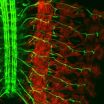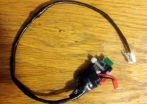(Press-News.org) Boston, MA -- In the wake of the horrific school shootings in Newtown, Conn. in December, three Harvard experts say the best way to curb gun violence in the U.S. is to take a broad public health approach, drawing on proven, evidence-based strategies that have successfully reduced other public health threats like smoking, car crashes, and accidental poisonings.
The authors make the case for a comprehensive public health approach to gun violence in a viewpoint article published online January 7, 2013 in the Journal of the American Medical Association (JAMA).
For instance, in much the same way that media, celebrities, peers, teachers, and physicians worked together in the latter decades of the 20th century to "de-glorify" cigarettes—previously seen as symbols of power, modernity, and sexuality—an analogous campaign "could justifiably equate gun violence with weakness, irrationality, and cowardice" and reduce its glorification in movies, television, and video games, the authors write.
Policy debates and discussions have largely focused on issues relating to gun ownership, such as banning assault weapons, instituting waiting periods for purchases, and requiring universal background checks. However, gun violence is a public health problem arising from additional sociocultural, educational, behavioral, and product safety issues that transcend gun ownership alone, say the authors.
"Gun violence is a public health crisis, and addressing this will require a comprehensive, multi-dimensional public health strategy," said lead author Dariush Mozaffarian, associate professor in the Department of Epidemiology at Harvard School of Public Health (HSPH). "Our past successes in reducing other harmful behaviors and accidents provide a set of evidence-based tools to address the many underlying root causes of gun violence."
Mozaffarian is a preventive cardiologist with expertise in lifestyle and behaviors. His co-authors include David Hemenway, professor of health policy at HSPH and an economist with expertise in gun violence; and David Ludwig, director of the New Balance Foundation Obesity Prevention Center at Boston Children's Hospital and professor of pediatrics at Harvard Medical School.
"Gun violence prevention has become highly politicized in the U.S.," said Ludwig, a pediatrician with expertise in child health promotion. "For this reason, we drew from past public health successes to craft an objective plan that could be considered for immediate action."
With more than 30,000 Americans killed by guns each year—85 deaths per day—setting limits and regulations on gun ownership is just one aspect to be considered in curbing the violence, the authors say.
They offer more than a dozen recommendations, based on successful strategies used in other public health crises. For example, they suggest a new, substantial national tax on all firearms and ammunition, to more accurately reflect the true societal costs of gun ownership and to provide a stable revenue source to target gun violence prevention. Such a tax would function like the tobacco tax, which provides crucial funding for smoking prevention efforts.
Other "off-the-shelf" approaches to preventing gun violence can be borrowed from efforts used in the 1970s to prevent accidental poisonings, the authors say. In the case of potentially harmful drugs, child safety packaging was introduced. In the case of guns, a similar strategy would be the manufacture of "smart guns" with security codes or locking devices. Also, routine education and counseling by physicians and national networks for education and prevention helped significantly reduce childhood poisoning deaths; similar efforts could help curb gun-related deaths.
Public health efforts to reduce motor vehicle deaths also offer ideas that could help prevent gun violence. Strategies included systematic safety standards for the driver (like driver education and licensing and drunk-driving legislation) and the vehicle (like safety glass and air bags). Similarly, strategies to reduce gun violence might include things like mandatory gun safety classes, penalties for violators of gun safety laws, reduced magazine clip sizes, and restrictions on rapid-fire firearms.
"Changing social norms is a fundamental public health strategy," said Hemenway. "For common products like cigarettes, cars, and guns, many individuals, groups, and institutions need to become involved. As 'friends don't let friends drive drunk,' similarly friends should help ensure that a friend going through a psychological crisis doesn't have ready access to a firearm until the crisis is over."
"Safety standards for gun ownership still represent one key facet of a comprehensive approach, just as automobiles and medications are widely used but subject to sensible safety policies," the authors conclude. "A coordinated, multi-dimensional public health strategy, informed by other public health successes, will reduce the risk of future tragedies like the Newtown shooting and the broader scourge of gun violence."
###
"Curbing Gun Violence—Lessons from Public Health Successes," Dariush Mozaffarian, David Hemenway, and David S. Ludwig, Journal of the American Medical Association, online Jan. 7, 2013.
Visit the HSPH website for the latest news, press releases and multimedia offerings.
Harvard School of Public Health is dedicated to advancing the public's health through learning, discovery, and communication. More than 400 faculty members are engaged in teaching and training the 1,000-plus student body in a broad spectrum of disciplines crucial to the health and well being of individuals and populations around the world. Programs and projects range from the molecular biology of AIDS vaccines to the epidemiology of cancer; from risk analysis to violence prevention; from maternal and children's health to quality of care measurement; from health care management to international health and human rights. For more information on the school visit: http://www.hsph.harvard.edu
HSPH on Twitter: http://twitter.com/HarvardHSPH
HSPH on Facebook: http://www.facebook.com/harvardpublichealth
HSPH on You Tube: http://www.youtube.com/user/HarvardPublicHealth
HSPH home page: http://www.hsph.harvard.edu
Comprehensive public health approach urged to curb gun violence in US
2013-01-08
ELSE PRESS RELEASES FROM THIS DATE:
Molecular '2-way radio' directs nerve cell branching and connectivity
2013-01-08
Working with fruit flies, Johns Hopkins scientists have decoded the activity of protein signals that let certain nerve cells know when and where to branch so that they reach and connect to their correct muscle targets. The proteins' mammalian counterparts are known to have signaling roles in immunity, nervous system and heart development, and tumor progression, suggesting broad implications for human disease research. A report of the research was published online Nov. 21 in the journal Neuron.
To control muscle movements, fruit flies, like other animals, have a set of ...
UI researcher learns mechanism of hearing is similar to car battery
2013-01-08
University of Iowa biologist Daniel Eberl and his colleagues have shown that one of the mechanisms involved in hearing is similar to the battery in your car.
And if that isn't interesting enough, the UI scientists advanced their knowledge of human hearing by studying a similar auditory system in fruit flies—and by making use of the fruit fly "love song."
To see how the mechanism of hearing resembles a battery, you need to know that the auditory system of the fruit fly contains a protein that functions as a sodium/potassium pump, often called the sodium pump for short, ...
AMSSM issues position statement on sport-related concussions
2013-01-08
Philadelphia, Pa. (January 7, 2013) - Athletes with concussions must be held out of practice or play until all symptoms have resolved, to avoid the risk of further injury during the vulnerable period before the brain has recovered. That's among the key recommendations in the new American Medical Society for Sports Medicine (AMSSM) position statement on concussions in sport, which appears in the January issue of Clinical Journal of Sport Medicine. The journal is published by Lippincott Williams & Wilkins, a part of Wolters Kluwer Health.
At a time of increased concern ...
Penn researchers show new level of control over liquid crystals
2013-01-08
PHILADELPHIA — Directed assembly is a growing field of research in nanotechnology in which scientists and engineers aim to manufacture structures on the smallest scales without having to individually manipulate each component. Rather, they set out precisely defined starting conditions and let the physics and chemistry that govern those components do the rest.
An interdisciplinary team of researchers from the University of Pennsylvania has shown a new way to direct the assembly of liquid crystals, generating small features that spontaneously arrange in arrays based on ...
Computer scientists find vulnerabilities in Cisco VoIP phones
2013-01-08
New York, NY—January 7, 2013—Columbia Engineering's Computer Science PhD candidate Ang Cui and Computer Science Professor Salvatore Stolfo have found serious vulnerabilities in Cisco VoIP (voice over internet protocol) telephones, devices used around the world by a broad range of networked organizations from governments to banks to major corporations, and beyond. In particular, they have discovered troubling security breaches with Cisco's VoIP phone technology. At a recent conference on the security of connected devices, Cui demonstrated how they can easily insert malicious ...
Black and Hispanic patients less likely to complete substance abuse treatment, Penn study shows
2013-01-08
PHILADELPHIA – Roughly half of all black and Hispanic patients who enter publicly funded alcohol treatment programs do not complete treatment, compared to 62 percent of white patients, according to a new study from a team of researchers including the Perelman School of Medicine at the University of Pennsylvania. Comparable disparities were also identified for drug treatment program completion rates. The study, published in the latest issue of Health Affairs, shows that completion disparities among racial groups are likely related to differences in socioeconomic status and, ...
Obese moms risk having babies with low vitamin D
2013-01-08
CHICAGO --- Women who are obese at the start of their pregnancy may be passing on insufficient levels of vitamin D to their babies, according to a new Northwestern Medicine® study.
The study found that babies born to lean mothers had a third higher amount of vitamin D compared to babies born to obese moms.
Vitamin D is fat-soluble, and previous studies have found that people who are obese tend to have lower levels of the vitamin in their blood. In this study, both obese and lean mothers had very similar levels of vitamin D at the end of their pregnancies, yet obese ...
Southern Medical Journal presents special issue on disaster preparedness
2013-01-08
Philadelphia, Pa. (January 7, 2013) – Surveys suggest that while most US physicians are willing to play a role in responding to natural and manmade disasters, most do not feel adequately prepared to fulfill that role. Toward helping physicians and health care systems understand and fulfill their obligation to provide medical care in disasters, the January Southern Medical Journal is a special issue on disaster medicine and physician preparedness. The official journal of the Southern Medical Association, the SMJ is published by Lippincott Williams & Wilkins, a part of Wolters ...
Study looks at how states decide which child receives early intervention for developmental problems
2013-01-08
AURORA, Colo. (Jan. 7, 2013) A new study out by researchers at the University of Colorado School of Medicine, found large differences in the criteria that states use to determine eligibility for Part C early intervention services for infants and toddlers who have developmental delays. A developmental delay is any significant lag in a child's development as compared with typical child development.
Current eligibility criteria for Part C services vary from state to state. With their colleagues, Steven Rosenberg, PhD, associate professor, University of Colorado Department ...
At least 1 in 6 stars has an Earth-sized planet
2013-01-08
The quest for a twin Earth is heating up. Using NASA's Kepler spacecraft, astronomers are beginning to find Earth-sized planets orbiting distant stars. A new analysis of Kepler data shows that about 17 percent of stars have an Earth-sized planet in an orbit closer than Mercury. Since the Milky Way has about 100 billion stars, there are at least 17 billion Earth-sized worlds out there.
Francois Fressin, of the Harvard-Smithsonian Center for Astrophysics (CfA), presented the analysis today in a press conference at a meeting of the American Astronomical Society in Long Beach, ...




